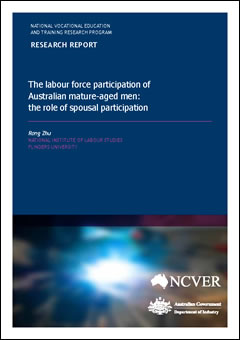Description
An important policy concern for many Organisation for Economic Co-operation and Development (OECD) countries, including Australia, has been the potential impacts on society of an ageing population. This paper investigates the labour force participation decisions made by mature-aged Australian couples from 2001 to 2011, using data from the Household, Income and Labour Dynamics (HILDA) survey. This study questions a fundamental issue regarding our understanding of labour force participation in today's research; namely, whether we should assume that the labour force decisions made by couples are interdependent or not. The paper finds evidence that the choice of the wife to participate in the labour force influences directly the decision of the husband to participate. Interestingly, the reverse does not hold true. The authors illustrate a need to base policy thinking on the joint modelling of labour force participation decisions between couples.
Summary
About the research
An important policy concern for many Organisation for Economic Co-operation and Development (OECD) countries, including Australia, has been the potential impact on society of an aging population. Labour force participation and retirement decisions are of particular interest and in Australia one policy focus has been on keeping mature-aged people in employment longer, the rationale being that this may mitigate the impacts on areas such as pension and health systems.
While the participation rate for mature-aged men and women in the labour force has increased significantly over the last decade, there are several factors which influence the decision to work or not. Using data from the Household, Income and Labour Dynamics in Australia (HILDA) Survey, the research addresses the interdependence of the labour force participation decisions of mature-aged couples from 2001 to 2011.
This research was funded with a grant that provides an opportunity for early-career researchers from disciplines such as economics and the social sciences to undertake a modest research project in a topic relevant to NCVER’s remit.
Key messages
- The wife’s choice to participate in the labour force influences directly the husband’s decision to participate. Interestingly, the reverse does not hold true.
- The increased participation of married women in the labour force resulted in a four-percentage-point increase in the participation of mature-aged married men between 2001 and 2011.
- This relationship exists even when the persistence of labour force participation of mature-aged married men is taken into account.
The paper identifies that strategies and policies to increase workforce participation need to be based on joint modelling of the labour force decisions of couples. If there is a desire to increase the workforce participation of mature-aged men, policy should also consider increasing the participation of women.
Rod Camm
Managing Director, NCVER
Executive summary
This paper investigates the labour force participation decisions made from 2001 to 2011 by older Australian couples. It focuses on couples with a mature-aged husband and estimates the interdependence of the labour force participation decision of the couple using data from the Household, Income and Labour Dynamics in Australia (HILDA) Survey.
This study questions the understanding of labour force participation in today’s research; namely, whether the labour force decisions made by couples are interdependent or not.
The paper contains several sophisticated empirical investigations that use the HILDA Survey for the years 2001 to 2011. The paper also applies a decomposition analysis, which allows us to judge the macroeconomic relationship between male and female employment in the context of how the increase in wives’ labour force participation leads to corresponding increases in the participation of their husbands.
The paper finds evidence that the employment of wives encourages the employment of their mature-aged husbands. The paper estimates that the increased participation of married women in the labour force between 2002 and 2011 has been responsible for about a four-percentage-point increase in the participation of their mature-aged husbands.
This paper makes some contributions to the present literature. First, it uses a broad array of advanced econometric methods and shows how these can be crucial for the correct understanding of the evidence. Second, it provides supportive arguments to caution against the use of analysis that ignores the interdependence of the decisions of wives and husbands. Third, the paper offers novel evidence on the macroeconomic development of employment rates in Australia: the positive impact exerted by increasing female employment rates on male employment rates, which shed new light on the complementarity between male and female employment.
Download
| TITLE | FORMAT | SIZE | |
|---|---|---|---|
| Participation-mature-aged-men-2702 | 521.2 KB | Download | |
| Participation-mature-aged-men-2702 | .docx | 741.0 KB | Download |
Related items
Married women who are active in the workforce play a significant role in influencing their husbands… Show more
